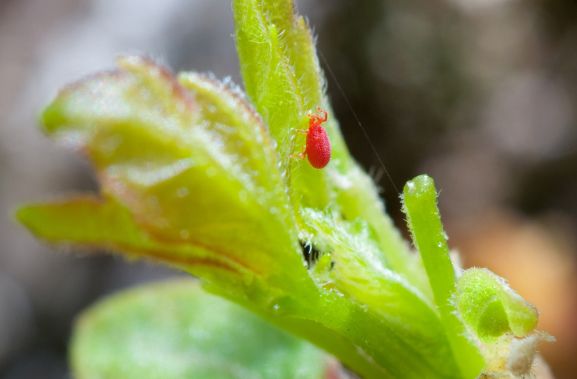Pest Alert: Spider Mites Love the Heat
August 9, 2016 | By webadmin
In the midst of summer, as temperatures soar and plants become more stressed, pest can move in quickly. Plants that are stressed naturally attract more pests and are more suceptible to diseases. As is typical this time of year, you may have noticed a spike in pests such as scale on crape myrtles and pests in our lawns. Another destructive pest to keep an eye out for now is the persistent spider mite.
What are spider mites?
These tiny creatures look like dots on the undersides of foliage. Up close, they look much like their close relative, the spider. There are thousands of species of spider mites from the Tetranychidae family. Most that you’ll see in North Texas are very small, oval shaped and either reddish brown or pale brown in color. Because spider mites live in large colonies, they can do a lot of damage in spite of their tiny size. They feed through the plant leaves, sucking out nutrients and water. Plant leaves then turn yellow, dry out, curl and fall off. You will also find very fine, light webbing on branches.

Spider mites are most active in summer, as they prefer hot, dry conditions. They’re prolific creatures, laying up to 300 hundred eggs over just a few weeks in winter. Once they hatch in spring, the warmer the weather, the quicker they are to develop and will often overlap multiple generations in just one season of mating. Junipers, berries, trees, shrubs and even houseplants are all susceptible to spider mites, especially plants that are drought stressed or already in decline.
Protect Your Plants
Your best defense is a good offense when it comes to keeping your landscape free of pests and diseases. Plants that are watered the right way, planted properly and chosen wisely for their location will be the most naturally protected. A balanced, healthy, organic landscape will naturally attract beneficial insects such as ladybugs to protect your plants for you. Ladybug larvae are especially fond of devouring spider mites.
Spider mite eggs overwinter on the leaves and branches of plants, then they hatch as spring temperatures begin to warm. To stave off a new spring crop of spider mites, horticultural oils can be applied to perennial plants and shrubs in late-winter and early spring to reduce mites, scale, aphids, leafhoppers, leafrollers, mealybugs, and tent caterpillars. Once applied to plants, the oil destroys internal cells of the insects or suffocates them by covering their breathing tubes. During the heat of summer, only spray horticultural oils in the morning, then rinse before plants are subjected to hot afternoon sun.
Are you a Roundtree Landscaping maintenance plan client? We’re always on the lookout for seasonal pests in your landscape.
